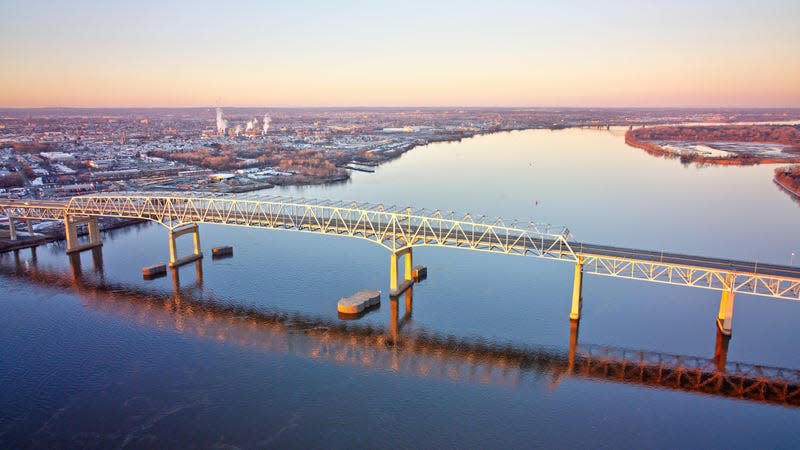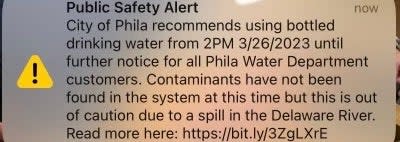What to Know About Philly's Tap Water After Chemical Spill

The Delaware River separates Philadelphia, PA from New Jersey. Much (though not all) of the city’s tap water supply comes from the river.
Residents of Philadelphia, Pennsylvania are currently grappling with uncertainty and anxiety surrounding their tap water. On Friday night, more than 8,000 gallons of hazardous chemicals spilled into Otter Creek (also known as Mill Creek), which flows into the Delaware River, the largest source of drinking water for the city.
Based on testing, Philadelphia’s tap water remains safe to drink through at least Tuesday afternoon, according to local officials.
Read more
These Winning Close-Up Photos Show Life That's Often Overlooked
Remembering Enterprise: The Test Shuttle That Never Flew to Space
“The Philadelphia Water Department (PWD) is confident that tap water from the Baxter Drinking Water Treatment Plant will remain safe to drink and use at least through 3:30 p.m. tomorrow (Tuesday, March 28, 2023.) This assurance is due to the treatment and continuous testing of water that is currently available to residents,” the city noted in its latest update at 5 p.m. ET on Monday.
The update expands on previous assessments that said the water would be safe to drink through at least Monday night. This earlier guidance was also echoed in a text alert transmitted to cell phones in the Philly area.

A text message alert sent out to Philadelphia residents on Sunday. An earlier alert urged them to avoid tap water entirely, our of “an abundance of caution” and created a run on bottled water.
The city’s safety assessment could change after Tuesday afternoon, per the city’s water department, yet officials say it’s unlikely. The water department “expects that there will be no contamination of residual water in the Delaware River by Wednesday or Thursday this week,” per the city website.
It’s “very likely [any remaining pollution] will not enter the Philadelphia water system,” said Mike Carrol, the deputy managing director of the city’s Office of Transportation Infrastructure and Sustainability, in a Monday evening briefing. “Under no circumstances do we expect this condition to last any longer than some point next week,” Carrol also said.
Based on models of river flow, he explained that all of the water that was present in the river at the time of the spill will have passed by the water treatment facility and towards the Delaware Bay and Atlantic Ocean between Wednesday night and Thursday morning. At this time, city officials said there is no visible or detectable pollution plume in the river between Otter Creek and the Baxter treatment plant.
However, officials continued to recommend that residents in the affected area abide by general FEMA guidelines and fill up water containers at home to maintain a 3-day emergency supply, in the Monday evening press conference.
Previously, Philadelphia advised residents to switch to bottled water in an earlier emergency alert on Sunday. Officials later updated that advisory following testing and said the tap water is safe to drink for the time being.

The first Sunday alert that Philadelphia residents received advised them to drink bottled water, and avoid tap water.
Yet, though later walked-back, the alert stoked panic and caused a run on bottled water locally. Many Philadelphia-area grocery stores ran out, according to reports from The Philadelphia Inquirer and other outlets. In one anecdote, a Philadelphia-based friend texted me to say that an ACME grocery in North Philly was advising people to buy Gatorade as an alternative to water over the store’s PA system.
Outside of Philadelphia, other municipalities are also monitoring water safety. Multiple New Jersey counties have declared their water is safe to drink and use, but some have issued voluntary water conservation guidelines.
What Happened to Philadelphia’s Water?
The small chemical spill was reported at around 11:40 p.m. on Friday, according to a Coast Guard press release. The company responsible, Trinseo Altuglas LLC, said that the spill was the result of an “equipment failure” at its Bristol facility in a Sunday news statement. It claimed that 8,100 gallons of a synthetic latex solution “overflowed the on-site containment and entered a storm drain, where it flowed to Otter Creek and then to the Delaware River,” in the release.
Altuglas makes acrylic resin and other plastic materials. The company and city officials have described the mixture spilled into Otter Creek as a “latex product” or “latex emulsion.” Butyl acrylate, ethyl acrylate, and methyl methacrylate are all chemicals thought to be in the spilled solution, according to the city—and it’s these three compounds that officials are testing and monitoring for.
Baxter Drinking Water Treatment Plant, Philly’s largest tap water provider, takes in water from the Delaware River downstream of the spill. The concern is that the pollution could therefore end up in a portion of the city’s drinking water. However, so far, officials have said none of the chemicals of concern have actually been detected at Baxter or elsewhere in the city’s water system. The treatment plant closed its intake for a period of time, but has since taken in water from the river. Tests showed no contamination in that water, officials reiterated in the Monday evening press conference.
Additionally, officials said no other impacts have been observed from the chemical spill. The city noted that there’ve been no fish kills or other visible environmental or wildlife effects of the spill so far.
Currently the Coast Guard and other agencies are working to clean up the spill. About 60,000 gallons of contaminated water have been removed so far, reported the Associated Press.
Are the Spilled Chemicals Dangerous?
The chemicals of concern (butyl acrylate, ethyl acrylate, and methyl methacrylate) are all known to be respiratory and skin irritants, above certain levels. However, less is known what impacts these chemicals have on human health when ingested, particularly with short-term exposure, Keeve Nachman, a toxicologist and environmental health researcher at Johns Hopkins University, told Gizmodo by phone Monday afternoon.
The Environmental Protection Agency has established a reference dosage for one of the three compounds, methyl methacrylate, which is considered the safe threshold for regular exposure. Based on that EPA reference dosage (1.4 milligrams per kg of bodyweight per day), a person would need to ingest a lot of methyl methacrylate to experience adverse health effects.
Ingestion symptoms for all three chemicals may include abdominal pain, nausea, vomiting, and diarrhea, according to the National Institutes of Heath’s PubChem. Yet to accurately assess risk of any symptoms, there would need to be data on exposure levels, said Nachman.
“We’d need to know more about how much of this chemical people [could] actually be getting through their drinking water, and for how long, before we comment on risk,” the toxicologist explained. Again though, the city has said that no detectable contamination has been found in the Philadelphia water system.
Regardless of the unknowns, Nachman seemed optimistic that this spill likely won’t cause serious harm. Usually, health impacts of water pollution are assessed over the long term, Nachman explained. If any contamination does manage to enter the water supply, it is likely to be a less dangerous, short-term exposure, he said. “It may be the case that people are not exposed long enough for us to be concerned about drinking water.”
Ultimately, if the contamination didn’t stay in the river or water supply for long, “it seems unlikely that people would get sick,” Nachman said.
Additionally, given the size of the spill, the chemical concentrations in the water are likely to be very low, if ever detectable. “What we’d be looking at would be very, very low levels,” of contamination—if any chemicals were to reach the water supply, said the city’s health commissioner, Cheryl Bettigole in the Monday press conference.
The 8,000+ gallons spilled is tiny, relative to the amount of water in the Delaware River as it passes through Philadelphia. For context, more than 1 million gallons flow through the waterway per second at Trenton, NJ and Penn’s Landing, according to USGS monitoring data.
For now, residents of Philadelphia should continue to stay up-to-date on their local advisories and alerts.
Update 3/27/2023, 6:06 P.M. ET: This post has been updated with additional information from a city of Philadelphia press statement and news briefing.
Update 3/27/2023, 5:49 P.M. ET: This post has been updated with additional information from a city of Philadelphia press statement and news briefing.
More from Gizmodo
Sign up for Gizmodo's Newsletter. For the latest news, Facebook, Twitter and Instagram.

